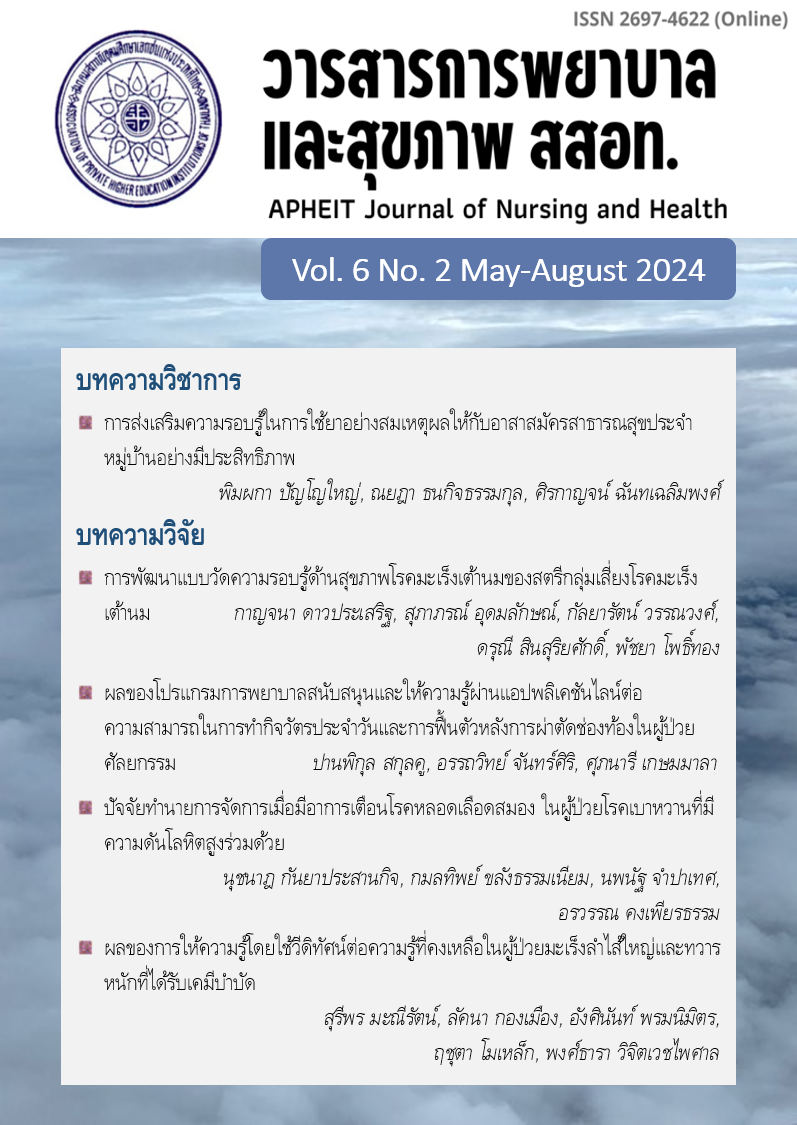Effective Enhancement of Health Literacy on the Rational Drug Use among Village Health Volunteers
Main Article Content
Abstract
Irrational drug use is a significant global public health issue that impacts individuals, families, and communities. Village Health Volunteers (VHVs) serve as community-based healthcare personnel closely connected with the public. They play a vital role in the healthcare for community members. Therefore, they should be encouraged to have a thorough understanding of rational drug use to reduce the issue of irrational drug use among the community population.
This article aims to describe the enhancement of health literacy in rational drug use (RDU) based on Nutbeam’s three levels of health literacy development: 1) functional health literacy, 2) interactive health literacy, and 3) critical health literacy. Additionally, it is aligned with the health literacy components outlined by the Ministry of Public Health, which include: 1) health service accessibility, 2) cognitive skills, 3) communication skills, 4) decision-making skills, 5) media literacy, and 6) self-management. The success factors for promoting rational drug use literacy among Village Health Volunteers (VHVs) involve fostering literacy through a step-by-step approach and implementing activities designed to develop the capabilities and skills. This serves as a guideline for enhancing rational drug use literacy among VHVs, which can be customized to fit each area’s context.
Article Details

This work is licensed under a Creative Commons Attribution-NonCommercial-NoDerivatives 4.0 International License.
เนื้อหาและข้อมูลในบทความที่ลงตีพิมพ์ในวารสารการพยาบาลและสุขภาพ สสอท. ถือเป็นข้อคิดเห็นและความรับผิดชอบของผู้เขียนบทความโดยตรง ซึ่งกองบรรณาธิการวารสารไม่จำเป็นต้องเห็นด้วย หรือร่วมรับผิดชอบใดๆ
บทความ ข้อมูล เนื้อหา รูปภาพ ฯลฯ ที่ได้รับการตีพิมพ์ในวารสารการพยาบาลและสุขภาพ สสอท. ถือเป็นลิขสิทธิ์ของวารสารการพยาบาลและสุขภาพ สสอท. หากบุคคลหรือหน่วยงานใดต้องการนำทั้งหมด หรือส่วนหนึ่งส่วนใดไปเผยแพร่ หรือเพื่อกระทำการใดๆ จะต้องได้รับอนุญาตเป็นลายลักษณ์อักษรจากวารสารการพยาบาลและสุขภาพ สสอท. ก่อนเท่านั้น
References
กรมควบคุมโรค กระทรวงสาธารณสุข. (2564). คู่มือกระบวนการสร้างความรอบรู้ด้านสุขภาพในการป้องกันควบคุมโรคและภัยสุขภาพ. กรุงเทพฯ: อาร์ เอ็น พี พี วอเทอร์.
กรมอนามัย กระทรวงสาธารณสุข. (2561). แนวคิดหลักการขององค์กรรอบรู้ด้านสุขภาพ. กรุงเทพฯ: สำนักงานโครงการขับเคลื่อนกรมอนามัย 4.0 เพื่อความรอบรู้ด้านสุขภาพของประชาชน (สขรส.).
กองบริหารการสาธารณสุข สํานักงานปลัดกระทรวงสาธารณสุข กระทรวงสาธารณสุข. (2563). แนวทางการดําเนินงานพัฒนาระบบการใช้ยาอย่างสมเหตุผลในชุมชน. นนทบุรี: กลุ่มงานพัฒนาระบบสนับสนุนบริการ กองบริหารการสาธารณสุข สํานักงานปลัดกระทรวงสาธารณสุข.
กองสุขศึกษา กรมสนับสนุนบริการสุขภาพ กระทรวงสาธารณสุข. (2554). ความฉลาดทางสุขภาพ. กรุงเทพฯ: นิวธรรมดาการพิมพ์.
กองสุขศึกษา กรมสนับสนุนบริการสุขภาพ กระทรวงสาธารณสุข. (2560). หลักสูตรฝึกอบรมมาตรฐานครูฝึกอบรมอาสาสมัครสาธารณสุขประจำหมู่บ้าน. นนทบุรี: เค. ที. เอส. มาร์เก็ตติ้ง ซัพพลาย.
ขวัญเมือง แก้วดำเกิง. (2561). ความรอบรู้ด้านสุขภาพ: เข้าถึง เข้าใจ และการนำไปใช้ (พิมพ์ครั้งที่ 2). กรุงเทพฯ: อัมรินทร์พริ้นติ้ง แอนด์ พับลิชชิ่ง.
คณะกรรมการพัฒนาระบบยาแห่งชาติ กระทรวงสาธารณสุข. (2566). แผนปฏิบัติการด้านการพัฒนาระบบยาของประเทศไทย (พ.ศ. 2566-2570). สืบค้น 1 พฤษภาคม 2567, จาก https://ndi.fda.moph.go.th/uploads/file_news/202309131994561417.pdf
ณยฏา ธนกิจธรรมกุล, พิมผกา ปัญโญใหญ่, และศิรกาญจน์ ฉันทเฉลิมพงศ์. (2567). ผลของโปรแกรมส่งเสริมความรอบรู้ด้านสุขภาพต่อความรอบรู้ในการใช้ยาปฏิชีวนะอย่างสมเหตุผลของอาสาสมัครสาธารณสุขประจำหมู่บ้าน. รายงานการวิจัยฉบับที่ 482 ทุนอุดหนุนการวิจัยจากมหาวิทยาลัยพายัพ.
ณัฐพล ผลโยน. (2566). การพัฒนาความรอบรู้ด้านสุขภาพและพฤติกรรมสุขภาพด้านการใช้ยาอย่างสมเหตุผลของอาสาสมัครสาธารณสุขประจำหมู่บ้าน อำเภอธาตุพนม จังหวัดนครพนม. วารสารโรงพยาบาลสกลนคร, 26(1), 89-100.
วิมลรัตน์ บุญเสถียร, และอรทัย เหรียญทิพยะสกุล. (2563). ความรอบรู้ด้านสุขภาพ: สถานการณ์และผลกระทบต่อสภาวะสุขภาพของผู้สูงอายุ. วารสารการพยาบาลและสุขภาพ สสอท., 2(1), 1-19.
วรวิทย์ นุ่มดี. (2563). พฤติกรรมการใช้ยาปฏิชีวนะของอาสาสมัครสาธารณสุขประจำหมู่บ้านในอำเภอเดิมบางนางบวช จังหวัดสุพรรณบุรี. วารสารมหาจุฬานาครทรรศน์, 7(7), 213–228.
ศุทธินี วัฒนกูล, ศศิธร ชิดนายี, พิเชษฐ์ แซ่โซว, ดำริห์ ทริยะ, ศิวิไล ปันวารินทร์, และพรฤดี นิธิรัตน์. (2563). ความรอบรู้ด้านการใช้ยาอย่างสมเหตุผลของอาสาสมัครสาธารณสุขประจำหมู่บ้าน. วารสารวิทยาลัยพยาบาลบรมราชชนนี อุตรดิตถ์, 12(2), 72-82.
สถาบันวิจัยระบบสาธารณสุข. (2541). นิยามศัพท์ส่งเสริมสุขภาพ ฉบับปรับปรุง พ.ศ. 2541 (พิมพ์ครั้งที่ 2). กรุงเทพฯ: ดีไซน์.
สุชาดา อินทรกำแหง ณ ราชสีมา, สมตระกูล ราศิริ, และธิติรัตน์ ราศิริ. (2564). บทบาทของอาสาสมัครสาธารณสุขไทย. วารสารวิจัยและพัฒนาด้านสุขภาพ สํานักงานสาธารณสุขจังหวัดนครราชสีมา, 7(2), 80-97.
Manganello, J. A. (2008). Health literacy and adolescents: A framework and agenda for future research. Health Education Research., 23(5), 840-847.
Nutbeam, D. (2000). Health literacy as a public health goal: A challenge for contemporary health education and communication strategies into the 21st century. Health Promotion International, 15(3), 259–267.
Nutbeam D. (2008). The evolving concept of health literacy. Social Science and Medicine, 67(12), 2072-2078.
Sørensen, K., Van den Broucke, S., Fullam, J., Doyle, G., Pelikan, J., Slonska, Z., Brand, H., & (HLS-EU) Consortium Health Literacy Project European. (2012). Health literacy and public health: A systematic review and integration of definitions and models. BMC public health, 12(80), 1-13.
World Health Organization. (1985). The rational use of drugs: Report of the conference of experts, Nairobi, 25-29 November 1985. Retrieved 1 May 2024, from https://iris.who.int/handle/10665/37174
World Health Organization. (1998). Health promotion glossary. Retrieved 1 May 2024, from https://iris.who.int/bitstream/handle/10665/64546/WHO_HPR_HEP_98.1.pdf?sequence=1
Most read articles by the same author(s)
- พิมผกา ปัญโญใหญ่, พีรนุช ลาเซอร์, Effective Instructional Design During the COVID-19 Pandemic , APHEIT Journal of Nursing and Health: Vol 3 No 3 (2021): September-December
